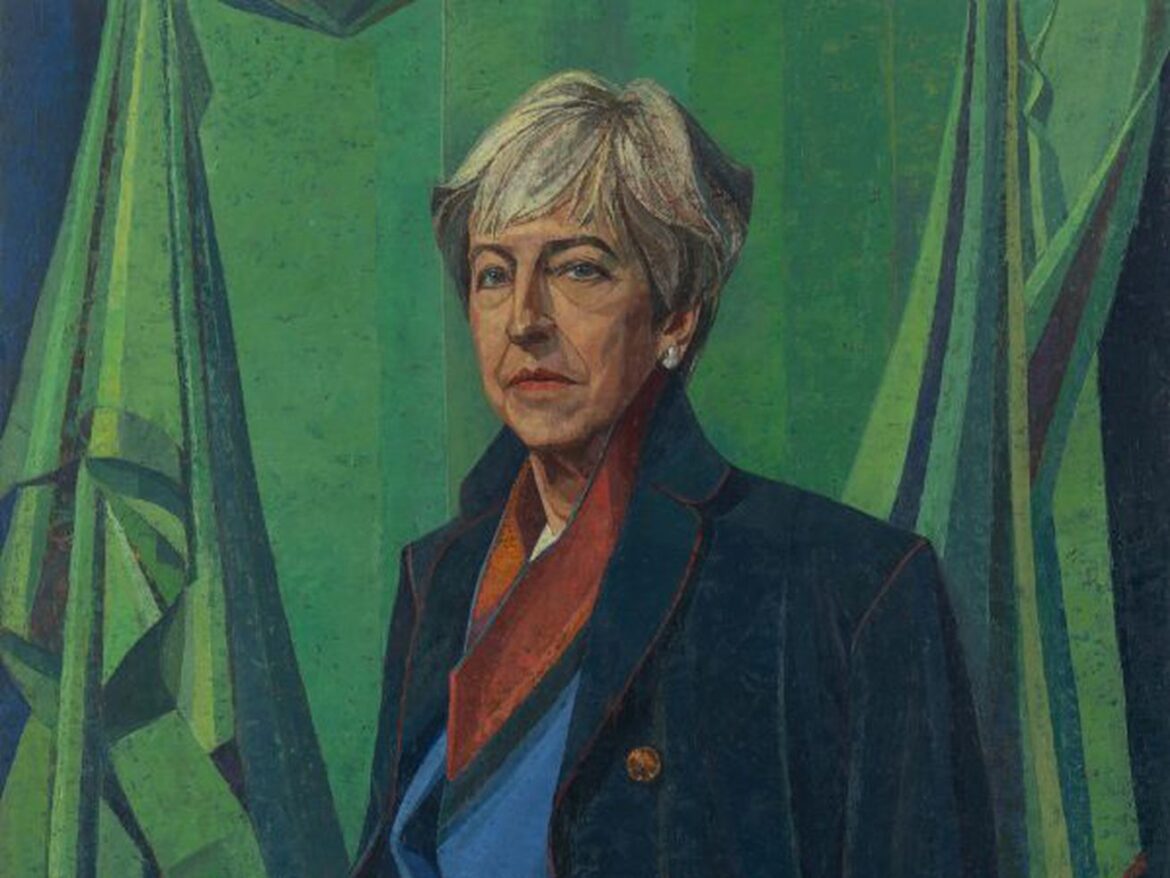If she looks like an enigma, that’s on purpose.
Maybe you’ve seen it already: that portrait of former British Prime Minister Theresa May, standing stoic, a bit steely even, with a military-esque blue coat draped over her shoulders. One hand, with red-painted fingernails, rests across her body. The other peeks out from beneath the coat and holds a lily of the valley, part of whose Latin name means “the month of May.”
If you haven’t seen it, here it is, but also, you may be wondering who cares about a painting of May, the British prime minister three prime ministers ago. Official portraits of politicians are not unusual, and these commissions tend to be somewhat honorary affairs: a record for posterity of a person in public service who had power and used it.
/cdn.vox-cdn.com/uploads/chorus_asset/file/24907544/Theresa_May_600x974.jpeg)
Saied Dai
But the unveiling this week of artist Saied Dai’s portrait — officially titled “The Rt Hon Theresa May MP” — revived a debate about who May was as a politician, before, during, and after her premiership. It initiated a parallel one about how to reconcile that history with her portrayal here, and whether this portrait reflected, remade, or somehow cauterized her tenure and the political tumult that came with it: May’s attempts to complete Brexit and all the political chaos that came after.
For Dai, the Tehran-born British artist who created the portrait, art isn’t conceived through the narrow prism of politics. That is the challenge of capturing a subject like May, or any other public figure: Our minds are probably made up. “You get an impression that people think that they know public figures,” Dai said.
This may be particularly true for May. She was Britain’s second female prime minister who won the impossible job of taking the United Kingdom out of the European Union. She tried, and still failed. To others, she was the Conservative leader who never really wanted Britain to leave the EU and spent three years at best bungling, and at worst betraying, whatever the ideal Brexit was.
Whichever side you come down on, the portrait manages to challenge it because, for lack of better words and for lack of me being an actual art critic, the portrait is incredibly arresting. It’s even … cool? If you’re going to suffer the worst defeat of any prime minister in history, at least you’ll be hanging on the walls of a Parliament building forever looking like this.
This is an unbearably cool portrait for May. Is she living in Weimar Germany, is she having an affair with Virginia Woolf, who can say https://t.co/8HBXrwpxsX
— Sian Cain (@siancain) September 5, 2023
Some saw this striking, imposing, maybe even hip depiction of May as not quite fitting of her record, her politics, or even her, I guess, vibe. “For a second, before I can remind myself of, say, the former home secretary’s “go home” vans or her flip-flopping around Brexit, Dai’s rendition of May, with its hints of an actual interior life, makes me think wait, did I have this person all wrong?” wrote Guardian columnist Emma Brockes. Michael Prodger, an editor at the New Statesman, wrote an article with the subhead that spoke of May’s “desire to remain statesmanlike, regardless of the febrile times of her premiership.” One user on X, formerly known as Twitter, simply wrote: “viscerally upset at how inaccurately & unjustly cool that official portrait makes Theresa May look.”
Dai said the best portraits have a sense of mystery. That may be the thing about May’s portrait; no one quite knows what to make of it because Dai intended to capture something else about May, not just a reproduction of her as the member of Parliament or former prime minister.
“People imagine that they know you, as all public figures. But I want to paint you as an enigma, rather than an open book,” Dai said. “I think that you can’t aim to do more than that. That’s not an evasion. That’s actually getting nearer to the truth of something than anything else.”
That enigmatic quality leaves May open to interpretation. It also lends itself to a little wish fulfillment.
Why a pretty routine thing for prime ministers turned into such a big deal
May’s tenure was sometimes likened to a “glass cliff” — a woman, thrust into leadership, forced to solve the dysfunction that she will also be blamed for.
When May entered office, she had the job of taking the UK out of the EU. She tried to forge a compromise on Brexit, one that would avoid economic and political catastrophe and avoid upsetting the peace in Northern Ireland. The deal pleased no one: The true Brexit believers wanted more, the Brexit opponents didn’t want it at all. She could not break the impasse in Parliament and could never win concessions from the EU that might satisfy her party. She protected the country from economic disaster by negotiating an extension of the deadline, but, in 2019, she admitted defeat, and Boris Johnson, a political rival, took her place.
Johnson took the UK out of the EU, but his deal papered over, rather than solved, the problems May encountered. The economic shocks of the exit were real, but they also coincided with Covid-19 and the Ukraine war. Because those effects were difficult to disentangle, people could pin the fallout, like a cost of living crisis, on whatever they wanted. Johnson met his downfall last year over Covid lockdown parties; his successor, Liz Truss, was forced to step down in a matter of weeks over her economic plans; and her replacement, Rishi Sunak, still has Brexit disputes to deal with. Brexit, in short, still looms: how much Britain has won, how much it has lost, and whether the UK should maybe rejoin the EU. Brexit will never be fully settled, and May was the one of the first, though perhaps not the last, casualty.
Which has helped make May seem a bit more sympathetic in hindsight. Plus, after her premiership, memes emerged of May living her “best life”: dancing at concerts, voting in Johnson’s no-confidence vote in a ballgown, opening a chocolate shop. It was a little like, free from the indignities of office, May was herself free, but also relishing that you maybe missed her a little bit.
And in Dai’s portrait, I think, this is what I want to see: a leader, duty-bound, who also has a little “I told you so” air about her. Maybe that’s silly, too much to get from a portrait. But either way, I’m still connecting it to politics — and perceptions about May.
As Dai said, he knows this exists, but they are not what guides the art. “All these things have to be carefully considered, and yet ignored,” he said.
Dai says the goal is to capture the subject — May — as a person. We did not talk politics directly, but he described May as decent and very principled and straightforward. “No matter what you may think about the politics and the policies, they’re just people thrust into impossible positions, trying to do the best that they can with what they have and what they have understood,” he said. But, Dai also said, he was “glad it wasn’t Boris Johnson.”
He also took a much longer view. A portrait, Dai says, has to be individual, but also archetypal. “That’s the only way that it will seem relevant and can speak over periods to all intelligent and sensitive and receptive people across different times,” he told Vox.
It is not unlike what he told May: In 50 years’ time, with respect, we are all going to be forgotten anyway. But the portrait probably will still be there. “What people will remember looking at a legacy like this — because it’s going to outlive both of us — is actually what kind of a person the object is. And that automatically gives you an indication of a greater picture of what they did, and what they didn’t do.”
The portrait doesn’t say, outright, what kind of person May is. But the most public act for a public figure like May — a portrait immortalizing her — somehow also reclaims some of her privacy. Which actually may be May, living her best life after all.



